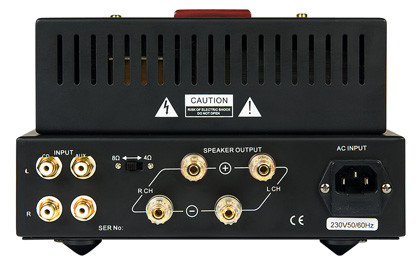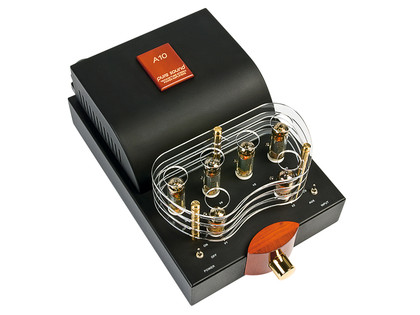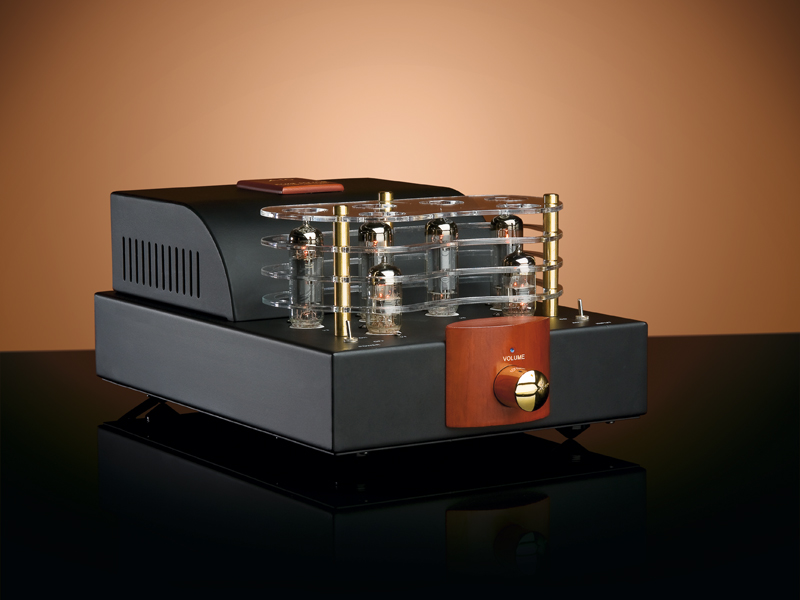TechRadar Verdict
The A10 is undoubtedly a superbly involving and musical amp at a very competitive price. In a sympathetic system it is capable of genuinely excellent results
Pros
- +
This small valve amplifier is well built
- +
Very competitively priced
- +
Offers superb audio performance
Cons
- -
With only 10 watts on tap, careful system matching is mandatory
- -
The relative lack of inputs may limit its appeal
Why you can trust TechRadar
Designed to demonstrate some of the star quality of the larger A30, the A10 integrated valve amplifier is the newest and least expensive arrival in a range from Pure Sound which includes amps, preamps and phono accessories.
In fact, due to market enthusiasm for the new amps, the A10 may well rule the roost in sub-£1,000 models.
Vacuum minimalism
The A10 is a class A Ultra Linear push-pull design. It uses a relatively conventional complement of valves, consisting of a pair of 6N3 valves in the preamp section and a quartet of 6P14 valves for the output stage.
Power is quoted at 10 watts per channel, and the output transformers are wound to accept either four or eight ohm loudspeaker loads. Internally, the amp is constructed from high-quality components such as carbon film resistors and polypropylene coupling capacitors, whilst the inputs are gold plated – which is no mean feat considering the price.
Special mention must also go to the volume control – a top-of-the-range film potentiometer. Not only does it have a smooth, fluid action, but it seems completely free of any channel imbalance, even at very low volumes.
Perhaps as a result of the impressive quality of the components specified by the designer, the feature set of the amp is somewhat limited; it sports a pair of line inputs selected by a two-position switch, a similar switch to power it on and off and that rather impressive-looking volume knob. Anyone seeking more inputs, phono stage or, indeed, a remote control will need to look elsewhere.
Sign up for breaking news, reviews, opinion, top tech deals, and more.

Pure Sound developed the A10 with a view to its use in both entry-level main systems and in second systems in bedrooms and studies where other Pure Sound models might prove too large or too expensive.
The 10 watt output will go a surprisingly long way if partnered correctly, but those interested in moving to an A10 from a more powerful solid-state amplifier will obviously need to ensure that their speakers are sensitive enough for it to generate reasonable listening levels – a great many of the better known and respected designs at this price point will not be.
For my listening tests, I chose a pair of Audio Note AN-K standmounts which have a high sensitivity to work with low output amplifiers and this pairing was able to generate ample real world volume levels in a fair-sized room.
Other suitable options are available from manufacturers such as Heco, Tannoy and Triangle.
Stout party
The fit and finish of the A10 is very good indeed. Despite its diminutive chassis, this amplifier tips the scales at no less than 8.5 kilograms and feels extremely solid with neatly rounded edges adding to the quality feel.
The wood trim around the volume knob is a neat visual touch and is matched by a plate on the transformer cover. As with a few other designs I have seen recently, the delicate valves are protected by a series of acrylic pieces separated by metal uprights. This is undoubtedly far easier on the eyes than a metal cage, although depending on how determined any of your offspring are, it's probably not as childproof.
The speaker terminals on the rear are large and solid three-way posts which should be able to accommodate all but the most enormous varieties of speaker cable.
The overall perception is that Pure Sound has preferred to reduce the feature count rather than the build and parts quality of the amp. This is precisely the way I would prefer manufacturers to approach constructing equipment for tight budgets.
In use, the A10 proves itself free of the idiosyncrasies and foibles which sometimes come with valve amplifiers and should prove a positive introduction to anybody who has selected one as their first foray into valves.
Setup is aided by an informative, well-written manual that should allow even a complete novice to get it running. The A10 warms up fully in less than 20 minutes and seems totally free of background noise or humming that can sometimes blight valve amps.
Pounds for Lbs
The overall result is that the A10 is one of the most cost effective ways of securing a well-built valve amp with high quality components throughout. Considered against other EL84 designs, it's less than half the price of similarly powerful models which is impressive considering how much remains.
On the negative side, it's limited to two sources, which may or may not concern you, and this can be overcome by adding inputs with a DAC or switching box.
The wider consideration, of course, with buying an amp with a limited power output is the likely need to buy suitable speakers for it to perform at its best. This is a more pronounced requirement than with a similarly priced solid-state amplifier.
A lot of bottle
Your willingness to invest in a new pair of speakers may increase significantly upon listening to it though. Half an hour with a properly partnered A10 and you will have found a way to manage with two inputs and 10 watts.
In keeping with many valve designs, the A10 brings a genuine sense of presence and realism to recordings. Artists and musicians are placed with an accuracy and depth of soundstage that moves well beyond the speakers.
Live recordings, in particular, bring an uncanny sense of the space they were recorded in, be it tiny club or cavernous stadium. Contained within it, instruments have the space they need to sound tangibly real and totally unprocessed.
Above all, voices come in for special treatment. Male or female, the A10 will place them with total assurance where they need to be, never divorced from their instruments, but equally never engulfed by them either.
Where the A10 is emphatically not in keeping with many valve amplifiers, particularly at this price point, is the speed and surprising grip it demonstrates. There is none of the bloat or softness that can reduce the impact of transients or quick bass lines – the A10 has a speed and agility that is often lacking in valve designs.
At the same time, the natural and unforced presentation does not seem to result in loss of detail and the all-important sense of excitement that can keep the attention for hours. In absolute terms, the bass – although fast and detailed – lacks the seismic quality normally only achieved with rather more power.

Once it has run out of volume, it can sound slightly strained – although it will hang on for longer than you might expect and never become unduly harsh or severely distorted. The classic comment that a valve watt seems burlier than a solid-state one certainly has some credence here.
Pure magic
Unfortunately, I cannot give an unconditional recommendation to the A10 as a perfect choice of amplifier at this price point. Many people who are already happy that their speakers are working well in their rooms are going to find the output of the A10 too limited to do justice to loudspeakers of average sensitivity.
Others will need more than two inputs, and may be unwilling to sacrifice remote control to get it. for those able to work within these limitations, however, the A10 demands an audition.
Simply put, it never fails to make music an enjoyable and rewarding experience, which is surely the purpose of a good hi-fi system in the first place. for many, this will be enough.
Follow TechRadar Reviews on Twitter: http://twitter.com/techradarreview

Ed Selley is a freelance writer who has been playing around with audio equipment – be it selling, supporting, marketing, installing or writing about it – for over 20 years. He worked with a variety of manufacturers before moving into reviewing over a decade ago and now writes about every category of equipment he can get his hands on. He owns more record players than any one human being strictly needs and an obsessively alphabetised record collection to use on it.
